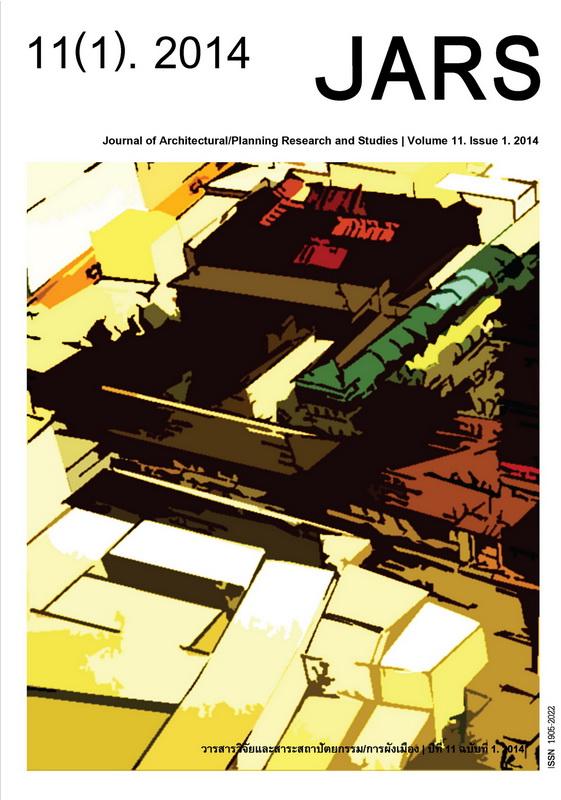Importance of Participatory Process in Urban Regeneration: Case Study of Wat Mangkorn Kammalawat MRT Station’s Surrounding Areas
Main Article Content
Abstract
The study project of the participatory process in urban regeneration around Wat Mangkorn Kammalawat MRT Station was initiated by landlords who were interested to develop their lands around the MRT Station, and was conducted by the representative from 2009 to 2010. Nevertheless, the project could not achieve the targets and was terminated. This research has objectives to determine the factors leading to the failure of the project, learn the flaw of the project running, and propose the ways to adjust the role of stakeholders and improve the working steps in urban regeneration. In 2011, I have summarized the knowledge from the project with local community and experts, listening to their comments and suggestions toward urban regeneration with participatory process. The results from the research found that all stakeholders need to adjust their roles. The landlords should be sincere to solve the problem and more involve with the project by participating in community meeting or being a part in the working team. Community should realize their importance toward district and should be united. Project researchers should set their position as the information provider and supporter only. The structure and working process of the project should be adjusted by including people from all sides, encouraging community to participate in problem solving, and conducting the public hearing when need to determine the conclusion in the future.
Downloads
Article Details

This work is licensed under a Creative Commons Attribution-NonCommercial-NoDerivatives 4.0 International License.
All material is licensed under the terms of the Creative Commons Attribution 4.0 International (CC-BY-NC-ND 4.0) License, unless otherwise stated. As such, authors are free to share, copy, and redistribute the material in any medium or format. The authors must give appropriate credit, provide a link to the license, and indicate if changes were made. The authors may do so in any reasonable manner, but not in any way that suggests the licensor endorses you or your use. The authors may not use the material for commercial purposes. If the authors remix, transform, or build upon the material, they may not distribute the modified material, unless permission is obtained from JARS. Final, accepted versions of the paper may be posted on third party repositories, provided appropriate acknowledgement to the original source is clearly noted.
References
Arnstein, S. R. (1969). A ladder of citizen participation. JAIP, 35(4), 216-224.
Arsom Silp Institute of the Arts. (2010). การศึกษาแนวทางการสร้างการมีส่วนร่วมในการฟื้นฟูและพัฒนาพื้นที่บริเวณ สถานีรถไฟฟ้าใต้ดินวัดมังกรกมลาวาส และพื้นที่ย่านเยาวราช,รายงานขั้นสุดท้าย [Research of the Guideline for Participatory Redevelopment of Wat Mangkorn Kammalawat MRT Station’s Surrounding Area and Yaowaraj: Final report]. Bangkok: Author.
District of Columbia Office of Planning (2009). Chinatown public realm plan draft district of Columbia government, USA, from http://planning.dc.gov/DC/Planning/Planning%20Publication%20Files/OP/Revitalization%20and%20Design/Draft_Chinatown%20Public%20Realm_web%2011.10.11.pdf
Kaenmepol, N., & Ungsuprasert, A. (2010). Participatory Chinatown สร้างเมืองผ่านโลกเสมือน[Participatory Chinatown: building city in virtual world]. Creative Thailand, 1(8), 20-23., from http://www.tcdc.or.th/creativethailand/article/CreativeCity/19572?CODE=CreativeCity&ID=19572
Usavagovitwong, N., Sapu, S., & Chairatananonda, P. (2012). ความเข้าใจชุมชนเมืองท่ามกลางกระแสทุน: กรณีศึกษา บนที่ดินซุปเปอร์บล็อคของสำนักงานทรัพย์สินส่วนพระมหากษัตริย์ [Understanding urban community amid capitalism: A case study of the crown property Bureau’s superblock]. Journal of Architectural/Planning Researchand Studies, 9(1), 27-42.
William, E. (1976). Electoral participation in a low stimulus election. Rural Development, 4(1), 111–124.


